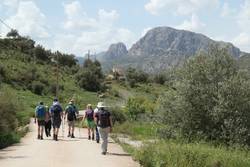Once upon a time there was a super continent called Pangea. Then one day (or possibly it took a little longer) it unzipped along what became the mid-Atlantic ridge. During the unzipping Africa twisted round and started squeezing up against Europe, creating the Alps whilst India smacked into Asia and created the Himalayas. During all the shifting about, southern Spain went from arid to a shallow tropical sea accumulating layer upon layer of deceased calcium carbonate shelled organisms. A few more eons of burying, squeezing and shoving from Africa and the resulting limestone rose up and went on to become the mountains of Granada. There they sat, quietly creating magnificent karst scenery and dramatic gorges, just waiting for a visit from Chelmsford YHA.
One of the gorges waiting for us was the infamous Caminito del Rey. The original path was built in 1901 as worker access for a hydroelectric scheme to provide power to Malaga.
The mighty Chorro river had spent centuries slicing its way through the mountains down to the sea. For the hydro scheme they took roughly half of that water into a carefully graded canal to provide the necessary fall at the far end to spin the turbines. Maintaining this canal was why the access path was needed. Needless to say, in 1901 workers health and safety was not high on the agenda and the path was neither wide nor protected with handrails. And that was when it was new.
The stupendously dramatic location meant that it attracted tourists almost from day 1. This included King Alfonso XIII of Spain who gave the path its name (Rey = King) after walking a short section in 1921. They were not generally encouraged, particularly as the path started to degrade and in the 1980s the path was closed. Officially. Unofficially you could duck round barriers and tip toe along the railway bridge dodging the trains. Following several deaths in the 90s and early 2000s, the authorities removed the first 30m of path making it impossible to walk, but for the very determined or foolhardy it was still possible to climb round. Naturally the accidents continued, some sources say 27 deaths and many more injuries.
In 2012 the decision was made to fully repair and refurbish the Caminito, and it formally re-opened in 2015 with a new walk way perched above the old one. It was this new, safe version of the path that we walked, not that previously known as “The Walk of Death”. It was lovely. There was even a little Jurassic ammonite waiting to remind us that this had all once been a peaceful shallow sea.
Ali
The Winds of Zafarraya
"It will be windy" the Cicerone said - and they were not wrong! After a very wiggly road up, we arrived at the Ventas de Zafarraya, which is a well frequented pass through the Sierra Tejeda, we saw lots of very big lorries on the hairpin bends.
There are large rocky hills either side of the pass, and we climbed both, a total of 585m, giving fantastic views over the mountains and down to the Vinela reservoir on one side, and onto the fertile plains on the other side. On the top of the first was a hole through the rocks, giving fantastic views of the mountains beyond. A railway used to run through the pass, which gave added interest to some in the group. By the way, despite the pass being windy, it was fine after we started climbing, and contrary to appearances, "Ventas" actually means a small bar or cafe!
Cress
The Abyss of Canillas
Canillas de Aceituno is a traditional Andalusian "white village". At the top of a winding mountain road, the narrow streets of whitewashed houses and Moorish arches stand at the foot of La Maroma, the highest mountain in Malaga Province. Our first walk from the village climbed part of "the snow gatherers path". As we ascended, enjoying fine views, thunder echoed ominously around the mountains, and heavy showers and a violent hailstorm meant we didn’t linger at the highest point.
In complete contrast, our second Canillas walk, "Sendero El Saltillo", followed the sun-sparkled water channels along gorge-side ledges to the source of the village's supply at a picturesque waterfall. A sign said "you have to be really fit and an expert in extreme trekking … dangers of fall into the abyss", but hanging walkways and an impressive new suspension bridge made our route spectacular rather than scary.
Dave P

